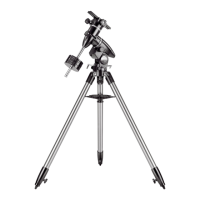Place the knob washer on the center support shaft
against the tray, and follow it by threading the securing
knob all the way up the center support shaft until it is
tight against the tray. The tripod support tray provides
additional stability for the tripod, and holds up to five
1.25" eyepieces and two 2" eyepieces.
6. Thread the counterweight shaft into the equatorial
mount at the base of the declination axis until tight.
Make sure the casting at the top is threaded clockwise
as far as it will go before attaching the shaft. Then turn
the casting counter-clockwise one the shaft is installed
until the top of the casting is flush with the mount.
7. Remove the knurled “toe saver” retaining screw on the
bottom of the counterweight shaft and slide both coun-
terweights onto the shaft. Make sure the counterweight
lock knobs are adequately loosened to allow the coun-
terweight shaft to pass through the hole. Position the
counterweights about halfway up the shaft and tighten
the lock knobs. Replace the toe saver at the end of the
bar. The toe saver prevents the counterweights from
falling on your foot if the lock knobs happen to come
loose.
8. Attach the slow-motion control knobs to the right ascen-
sion and declination gear shafts of the equatorial mount
by sliding them onto the shafts. Line up the flat end of
the gear shaft with the interior of the knob. The knobs
can be attached to either end of the shafts, whichever is
more convenient for you.
Your SkyView Pro EQ mount is now fully assembled and
should resemble Figure 1.
4. Attaching a Telescope
The SkyView Pro equatorial mount is designed to hold
telescope tubes weighing up to approximately 20 lbs.
For heavier telescopes, the mount may not provide suf-
ficient stability for steady imaging. Any type of telescope
can be mounted on the SkyView Pro, including refractors,
Newtonian reflectors, and catadiotropics, provided a set
of tube rings is available to couple the tube to the mount.
Orion sells a variety of telescope tube rings. Please visit
our website at telescope.com for details.
1. Attach the tube mounting rings to the tube mounting
plate using the attachment screws that came with tube
rings. The screws should go through the holes on the
outer ends of the mounting plate and rethread into the
tube rings. Note that the side of the mounting plate with
the central “groove” will be facing up.
2. Loosen the black mounting plate securing knob as well
as the metal safety screw on the top of the equatorial
mount. Place the mounting plate, with the tube rings
attached, in the dovetail slot on top of the equatorial
mount. Position the mounting plate so that it is cen-
tered on the dovetail slot. Re-tighten the mounting plate
securing knob until the mounting plate is secure. Then,
tighten the safety screw. The safety screw will ensure
that the mounting plate (and telescope tube) will not fall
off the EQ mount if the mounting plate securing knob
should come loose.
3. Open the tube rings and lay the telescope optical tube
in the rings at about the midpoint of the tube’s length.
Rotate the tube so that the focuser is at a convenient
height for viewing. Close the tube rings and tighten
them.
5. Balancing a Telescope
To ensure smooth movement of the telescope on both
axes of the equatorial mount, it is imperative that the opti-
cal tube is properly balanced. We will first balance the tele-
scope with respect to the right ascension axis, then the
declination axis.
1. Keeping one hand on the telescope optical tube, loos-
en the R.A. lock lever. Make sure the Dec. lock lever
is locked, for now. The telescope should now be able
to rotate freely about the right ascension axis. Rotate
it until the counterweight shaft is parallel to the ground
(i.e., horizontal).
2. Now loosen both counterweight lock knobs and slide
the weights along the shaft until they exactly counter-
balance the telescope (Figure 3a). That’s the point at
which the shaft remains horizontal even when you let
go with both hands (Figure 3b). If the telescope refuses
to balance, then you have either too much or too lit-
tle counterweight. Remove a counterweight if it is too
much, or add optional counterweights if it is too little.
Figure 3. Proper operation of the equatorial mount requires that
the telescope tube be balanced on both the R.A. and Dec. axes.
(a) With the R.A. lock lever released, slide the counterweights
along the counterweight shaft until it just counterbalances the
tube. (b) When you let go with both hands, the tube should not
drift up or down. (c) With the Dec. lock knob released, loosen the
tube ring lock clamps a few turns ands slide the telescope forward
or back in the tube rings. (d) When the tube is balanced about the
Dec. axis, it will not move when you let go.
4
a.
b.
c. d.

